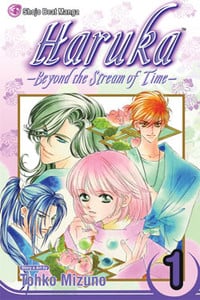Review
by Carl Kimlinger,Haruka -Beyond the Stream of Time-
GN 1
| Synopsis: |  |
||
Ordinary schoolgirl Akane, while busily appealing to the intended demographic of shojo readers, is lured to a cherry tree and promptly sucked into ancient Japan, along with platonic boy buddies Shimon and Tenma. Upon swallowing the eight dragon jewels, she is declared the Priestess of the Dragon God, an honored personage blessed—or cursed—with the power to destroy cities. She takes up residence in the palace of the capital city, where she discovers that there are eight, naturally hot and male, guardians destined to protect her, each with powers bestowed upon them by one of the dragon jewels. Once she reunites with hot-tempered, self-sufficient Tenma and innocent, sweet-natured Shimon, the hot guys around her get down to the business of protecting her from the demon tribe threatening the capital and generally appealing to the intended demographic of shojo readers. In the meantime Akane finds herself mysteriously drawn to Akram, the powerful—and let's not forget hot—demon that first called her into the past. Could it be love? |
|||
| Review: | |||
In the name of objectivity and fairness, this review won't mention the name of another time-traveling epic about an ordinary schoolgirl transported into the past, named a priestess, and protected by a bushel of bishies from a handsome blonde-haired, blue-eyed megalomaniac with persecution issues. Nor will it compare the two or point out similarities or use words like rip-off, knock-off, or cash-grab. No need to thank me. There's plenty else to discuss. Like how the book stampedes through the introductory phase—Akane is introduced, dropped into ancient Japan, and chosen as Priestess in under fifteen pages—cutting straight to the introduction of its bevy of beautiful boys, which would be good for fans of male eye-candy, did it not similarly stampede past drama, action, romance and characterization. To call the relationships between Akane and her pile of men simplistic is frankly flattering, and personalities can be summed up with phrases like "the sexy one" and "the quiet one." Akane's fixation on the leader of the demon tribe is the only hint of drama with potential, and Tenma the only character that inspires any sympathy. Though his fiery temper, protective devotion, and focus on the financial bottom line strongly recalls the over-protective, penny-pinching romantic lead from a different tale about an ordinary schoolgirl transported into the past, named a priestess, and protected by a bushel of bishies from a handsome blonde-haired, blue-eyed megalomaniac with persecution issues. In the short bio of Tohko Mizuno at the book's end, her artwork is characterized as having "delicate line work" and "rich textures and patterns." And indeed she is fond of fine, flowing lines, and the dark patterns on the clothing of Akram and Yorihisa, one of Akane's primary protectors, are striking. But that the character designs—particularly the hot male ones—show care and passion while visual continuity self-destructs under the weight of jumbled panel layouts and confusing action sequences betrays the fact that the manga, based on a game for which Mizuno did the character designs, was drawn by an artist inexperienced in the kind of visual storytelling required by the medium. The visual pace is all over the map, with throwaway images (usually of things Mizuno obviously enjoys drawing, like hot guys) consuming entire pages, while important events are squeezed into a series of confused panels at the bottom of a single page. Her grasp of continuity improves somewhat over the course of the book, but sequences that must be read multiple times to grasp what happens persist, especially during action sequences, drowned as they are in speed-lines and unnecessary background effects. The art that remains is standard at best: Akane is a boring everygirl, backgrounds are virtually non-existent, and flowers bloom across the page at the slightest provocation. Other than the standardized font on the spine, there's no difference between this book and Viz' non-Shojo Beat manga. It has an appropriately girly pink cover, sound effects replaced with English translations, and author's comments after the story. Instead of the usual quarter-page authorial sidebar commentaries, Mizuno prefers to fill the space with portraits of her men accompanied by poetry. If you remove Haruka's resemblance to a certain time-travelling epic about an ordinary schoolgirl transported into the past, named a priestess, and... Oh hell, forget it. If you removed Haruka's resemblance to Fushigi Yuugi, there wouldn't be anything left but bones. And let's just agree to call a rip-off a rip-off: Haruka is Fushigi Yuugi bled of all its delicious melodrama and minus Yuu Watase's skill with a pen. If you really need to read Fushigi Yuugi again, then just read it again. Even a second time through, it would be vastly preferable to this tired retread. |
| Grade: | |||
|
Overall : C-
Story : D
Art : C
+ Pretty boys. |
|||
| discuss this in the forum (49 posts) | | |||
| Production Info: | ||
|
Full encyclopedia details about Release information about |
||